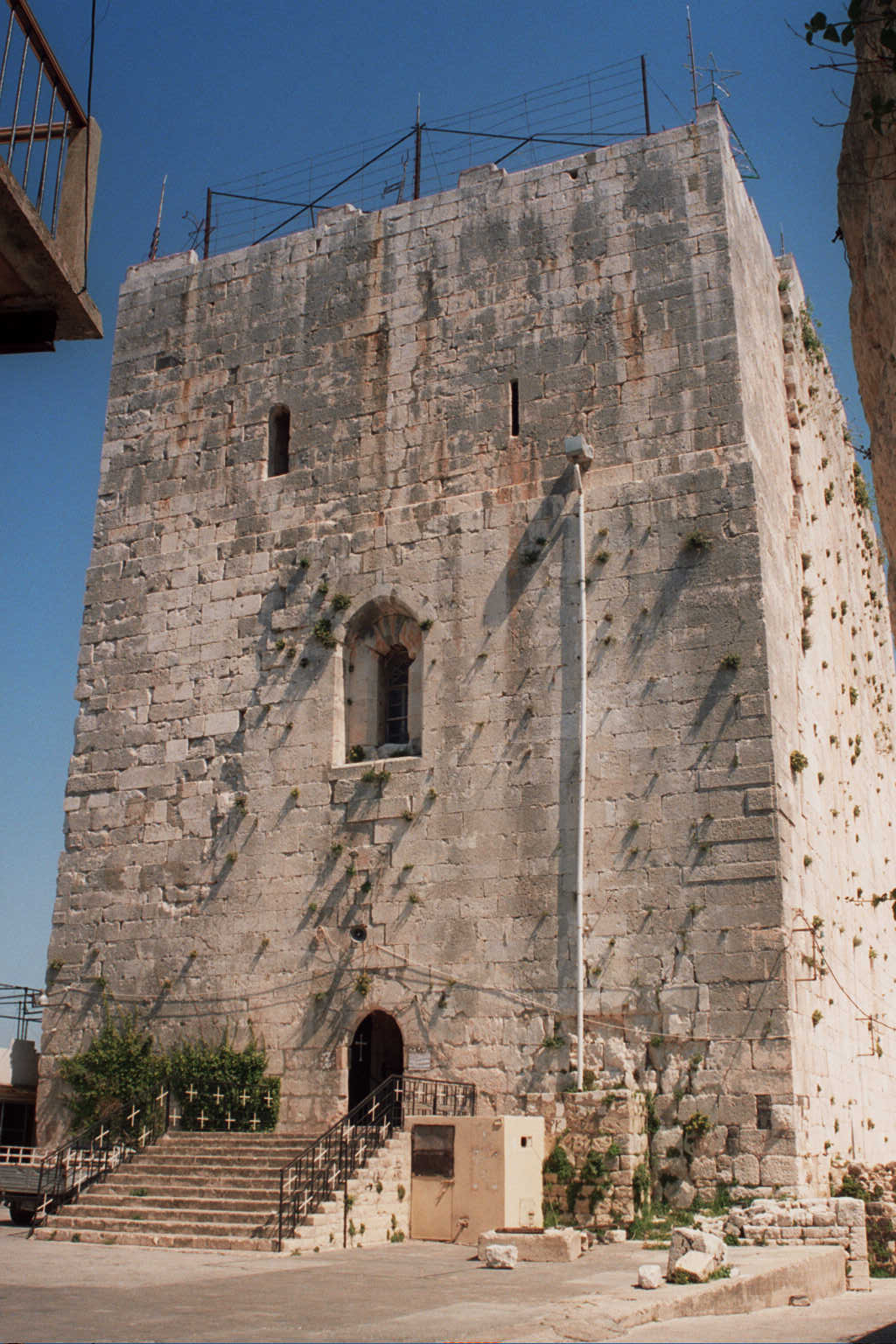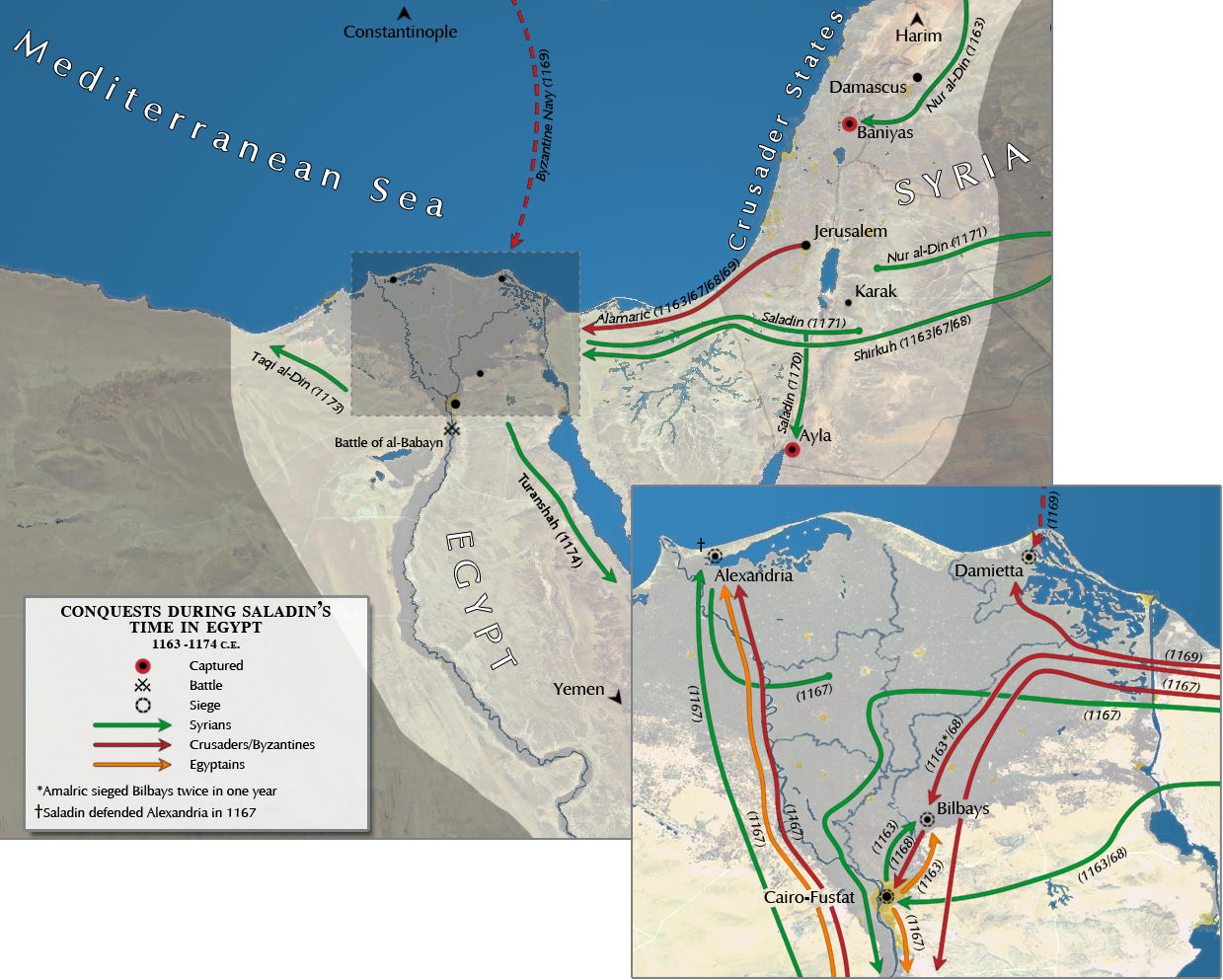|
Chastel Blanc
Chastel Blanc ( ar, برج صافيتا, Burj Safita or Safita Tower) is a medieval structure in Safita, western Syria. It was built by the Knights Templar during the Crusades upon prior fortifications. Located on the middle hill of Safita's three hills, it offers a commanding view of the surrounding countryside, and was a major part of the network of Crusader fortifications in the area. From the roof, a view ranging see from the Mediterranean Sea to the snow-covered mountains of Lebanon, and County of Tripoli, is offered. From Chastel Blanc it would have been possible to see the Templar strongholds at Tartus and Ruad Island to the northwest, Chastel Rouge on the coastline to the southwest, Akkar to the south, and Krak des Chevaliers (the headquarters of the Syrian Knights Hospitallers) to the southeast. History The region was initially controlled by the Crusaders by 1110, and was mentioned the first time in an Arab chronicle in 1112. The Knights Templar built a dungeon after 111 ... [...More Info...] [...Related Items...] OR: [Wikipedia] [Google] [Baidu] |
Safita
Safita ( ar, صَافِيتَا '; phn, 𐤎𐤐𐤕𐤄, ''Sōpūte'') is a city in the Tartous Governorate, northwestern Syria, located to the southeast of Tartous and to the northwest of Krak des Chevaliers. It is situated on the tops of three hills and the valleys between them, in the Syrian Coastal Mountain Range. According to the Syria Central Bureau of Statistics (CBS), Safita had a population of 20,301 in the 2004 census. Geography Safita is situated at the southeastern end of the Syrian Coastal Mountain Range. It is southeast of the Mediterranean port city of Tartus and northwest of Homs. The average elevation of Safita is above sea level, while the Crusader fortress stands about . History Safita is located on a site where remains of the Phoenician settlement were discovered. The archaeological remains at the site of Tell Kazel were identified as the Phoenician city of Sumur mentioned in the Amarna letters. Crusader era Raymond IV, Count of Toulouse fou ... [...More Info...] [...Related Items...] OR: [Wikipedia] [Google] [Baidu] |
Nur Ad-Din (died 1174)
Nūr al-Dīn Maḥmūd Zengī (; February 1118 – 15 May 1174), commonly known as Nur ad-Din (lit. "Light of the Faith" in Arabic), was a member of the Zengid dynasty, which ruled the Syrian province (''Shām'') of the Seljuk Empire. He reigned from 1146 to 1174. He is regarded as an important figure of the Second Crusade. War against Crusaders Nur ad-Din was the second son of Imad ad-Din Zengi, the Turkish '' atabeg'' of Aleppo and Mosul, who was a devoted enemy of the crusader presence in Syria. After the assassination of his father in 1146, Nur ad-Din and his older brother Saif ad-Din Ghazi I divided the kingdom between themselves, with Nur ad-Din governing Aleppo and Saif ad-Din Ghazi establishing himself in Mosul. The border between the two new kingdoms was formed by al-Khabur River. Almost as soon as he began his rule, Nur ad-Din attacked the Principality of Antioch, seizing several castles in the north of Syria, while at the same time he defeated an attempt by J ... [...More Info...] [...Related Items...] OR: [Wikipedia] [Google] [Baidu] |
Castles In Syria ...
This is a list of castles in Syria. Key List of castles See also * List of castles * List of Crusader castles References Sources * * * * * * * {{Castles in Syria Syria Castles Castles Syria Castles A castle is a type of fortified structure built during the Middle Ages predominantly by the nobility or royalty and by military orders. Scholars debate the scope of the word ''castle'', but usually consider it to be the private fortified r ... [...More Info...] [...Related Items...] OR: [Wikipedia] [Google] [Baidu] |
Gertrude Bell
Gertrude Margaret Lowthian Bell, CBE (14 July 1868 – 12 July 1926) was an English writer, traveller, political officer, administrator, and archaeologist. She spent much of her life exploring and mapping the Middle East, and became highly influential to British imperial policy-making as an Arabist due to her knowledge and contacts built up through extensive travels. During her lifetime, she was highly esteemed and trusted by British officials such as High Commissioner for Mesopotamia Percy Cox, giving her great influence. She participated in both the 1919 Paris Peace Conference (briefly) and the 1921 Cairo Conference, which helped decide the territorial boundaries and governments of the post-War Middle East as part of the partition of the Ottoman Empire. Bell believed that the momentum of Arab nationalism was unstoppable, and that the British government should ally with nationalists rather than stand against them. Along with T. E. Lawrence, she advocated for inde ... [...More Info...] [...Related Items...] OR: [Wikipedia] [Google] [Baidu] |
Phoenicia
Phoenicia () was an ancient thalassocratic civilization originating in the Levant region of the eastern Mediterranean, primarily located in modern Lebanon. The territory of the Phoenician city-states extended and shrank throughout their history, and they possessed several enclaves such as Arwad and Tell Sukas (modern Syria). The core region in which the Phoenician culture developed and thrived stretched from Tripoli and Byblos in northern Lebanon to Mount Carmel in modern Israel. At their height, the Phoenician possessions in the Eastern Mediterranean stretched from the Orontes River mouth to Ashkelon. Beyond its homeland, the Phoenician civilization extended to the Mediterranean from Cyprus to the Iberian Peninsula. The Phoenicians were a Semitic-speaking people of somewhat unknown origin who emerged in the Levant around 3000 BC. The term ''Phoenicia'' is an ancient Greek exonym that most likely described one of their most famous exports, a dye also known as Tyrian ... [...More Info...] [...Related Items...] OR: [Wikipedia] [Google] [Baidu] |
Mandate For Syria And The Lebanon
The Mandate for Syria and the Lebanon (french: Mandat pour la Syrie et le Liban; ar, الانتداب الفرنسي على سوريا ولبنان, al-intidāb al-fransi 'ala suriya wa-lubnān) (1923−1946) was a League of Nations mandate founded in the aftermath of the First World War and the partitioning of the Ottoman Empire, concerning Syria and Lebanon. The mandate system was supposed to differ from colonialism, with the governing country intended to act as a trustee until the inhabitants were considered eligible for self-government. At that point, the mandate would terminate and an independent state would be born. During the two years that followed the end of the war in 1918—and in accordance with the Sykes–Picot Agreement signed by Britain and France during the war—the British held control of most of Ottoman Mesopotamia (modern Iraq) and the southern part of Ottoman Syria ( Palestine and Transjordan), while the French controlled the rest of Ottoman Syria, ... [...More Info...] [...Related Items...] OR: [Wikipedia] [Google] [Baidu] |
Baibars
Al-Malik al-Zahir Rukn al-Din Baybars al-Bunduqdari ( ar, الملك الظاهر ركن الدين بيبرس البندقداري, ''al-Malik al-Ẓāhir Rukn al-Dīn Baybars al-Bunduqdārī'') (1223/1228 – 1 July 1277), of Turkic Kipchak origin, commonly known as Baibars or Baybars ( ar, بيبرس, ''Baybars'') – nicknamed Abu al-Futuh (; English: ''Father of Conquests'', referring to his victories) – was the fourth Mamluk sultan of Egypt and Syria in the Bahri dynasty, succeeding Qutuz. He was one of the commanders of the Egyptian forces that inflicted a defeat on the Seventh Crusade of King Louis IX of France. He also led the vanguard of the Egyptian army at the Battle of Ain Jalut in 1260, which marked the first substantial defeat of the Mongol army and is considered a turning point in history. The reign of Baybars marked the start of an age of Mamluk dominance in the Eastern Mediterranean and solidified the durability of their military system. He managed to pa ... [...More Info...] [...Related Items...] OR: [Wikipedia] [Google] [Baidu] |
1202 Syria Earthquake
The 1202 Syria earthquake struck at about dawn on 20 May 1202 (598 AH) with an epicenter in southwestern Syria. Up to 1,100,000 deaths have been associated with this earthquake, although other estimates are much smaller. It was felt over a very wide area, from Sicily to Mesopotamia and Anatolia to upper Egypt, mostly affecting the Ayyubid Sultanate and the Kingdom of Jerusalem. The cities of Tyre, Acre and Nablus were heavily damaged. A magnitude of 7.6 has been estimated with damage up to XI on the Mercalli intensity scale. Records of the earthquake A large earthquake or series of earthquakes is described in many written sources during the period 1201–1202 (597–598 AH). It is unclear as to whether they refer to a single mainshock with several large aftershocks or more than one unrelated earthquake. Given the rarity of such large events in this area it has been considered more likely that the reports all refer to the same mainshock. Other workers have recognised two sep ... [...More Info...] [...Related Items...] OR: [Wikipedia] [Google] [Baidu] |
Saladin
Yusuf ibn Ayyub ibn Shadi () ( – 4 March 1193), commonly known by the epithet Saladin,, ; ku, سهلاحهدین, ; was the founder of the Ayyubid dynasty. Hailing from an ethnic Kurdish family, he was the first of both Egypt and Syria. An important figure of the Third Crusade, he spearheaded the Muslim military effort against the Crusader states in the Levant. At the height of his power, Ayyubid territorial control spanned Egypt, Syria, Upper Mesopotamia, the Hejaz, Yemen, the Maghreb, and Nubia. Alongside his uncle Shirkuh, a military general of the Zengid dynasty, Saladin was sent to Egypt under the Fatimid Caliphate in 1164, on the orders of Nur ad-Din. With their original purpose being to help restore Shawar as the to the teenage Fatimid caliph al-Adid, a power struggle ensued between Shirkuh and Shawar after the latter was reinstated. Saladin, meanwhile, climbed the ranks of the Fatimid government by virtue of his military successes against Crusa ... [...More Info...] [...Related Items...] OR: [Wikipedia] [Google] [Baidu] |
1170 Syria Earthquake
The 1170 Syria earthquake was one of the largest earthquakes to hit Syria. It occurred early in the morning of 29 June 1170. It formed part of a sequence of large earthquakes that propagated southwards along the Dead Sea Transform, starting with the 1138 Aleppo earthquake, continuing with the 1157 Hama, 1170 and 1202 Syria events. The estimated magnitude is 7.7 on the moment magnitude scale, with the maximum intensity of X (''Extreme'') on the Mercalli intensity scale. Tectonic setting Western Syria lies across the boundary between the African Plate and the Arabian Plate, which consists of the various segments of the Dead Sea Transform. The main strand passing through the Lebanon restraining bend is the Yammouneh Fault, which was responsible for the 1202 earthquake. To the north of this is the Missyaf Fault (or Ghab Fault), which continues up to the Ghab Basin. One earlier earthquake has been identified on this fault segment, the 115 Antioch earthquake. The Missyaf Fault is con ... [...More Info...] [...Related Items...] OR: [Wikipedia] [Google] [Baidu] |
Knights Hospitaller
The Order of Knights of the Hospital of Saint John of Jerusalem ( la, Ordo Fratrum Hospitalis Sancti Ioannis Hierosolymitani), commonly known as the Knights Hospitaller (), was a medieval and early modern Catholic military order. It was headquartered in the Kingdom of Jerusalem until 1291, on the island of Rhodes from 1310 until 1522, in Malta from 1530 until 1798 and at Saint Petersburg from 1799 until 1801. Today several organizations continue the Hospitaller tradition, specifically the mutually recognized orders of St. John, which are the Sovereign Military Order of Malta, the Most Venerable Order of the Hospital of Saint John, the Bailiwick of Brandenburg of the Chivalric Order of Saint John, the Order of Saint John in the Netherlands, and the Order of Saint John in Sweden. The Hospitallers arose in the early 12th century, during the time of the Cluniac movement (a Benedictine Reform movement). Early in the 11th century, merchants from Amalfi founded a hospital ... [...More Info...] [...Related Items...] OR: [Wikipedia] [Google] [Baidu] |








